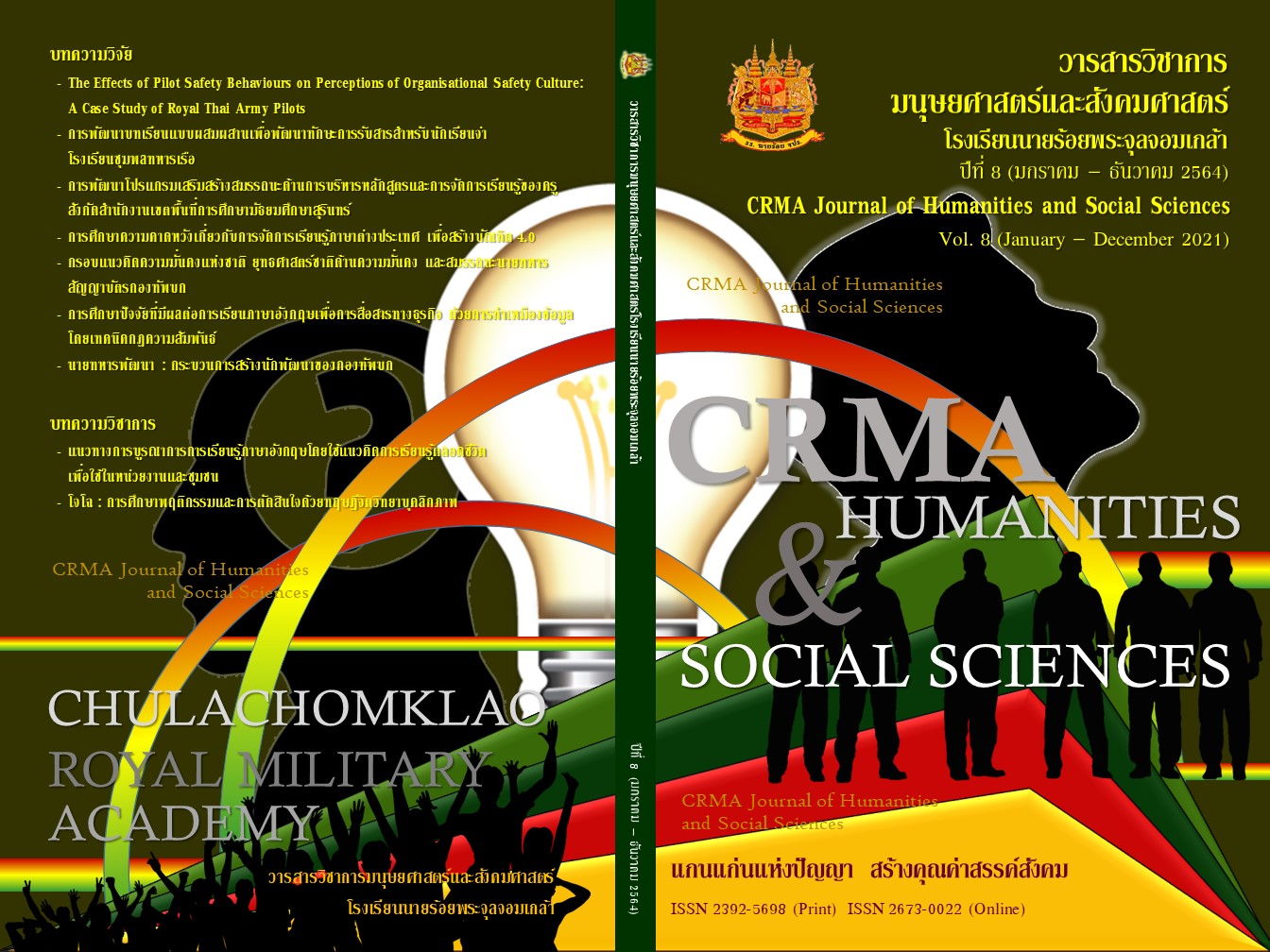THE EFFECTS OF PILOT SAFETY BEHAVIOURS ON PERCEPTIONS OF ORGANISATIONAL SAFETY CULTURE: A CASE STUDY OF ROYAL THAI ARMY PILOTS
Keywords:
Safety Behaviours, Pilot, Safety Culture, Royal Thai Army, Safety Management SystemAbstract
This study examined the pilot safety behaviours' effects on the perception of organisational safety culture among Royal Thai Army pilots. Data were collected from a sample of 202 Royal Thai Army pilots. A questionnaire was used as a research instrument to collect data. Data collected were then analysed using descriptive statistics and stepwise regression analysis. This study indicated that the four dimensions of safety behaviour, namely: intra-family relationship, job characteristics, health, and self-discipline are moderately correlated with the organisation's perceived safety culture (r = 0.59). The regression analysis shows that the safety behaviours in terms of self-discipline in aviation and job characteristics affected the organisation's perceived safety culture with a statistical significance level of 0.05.
References
Adjekum, D. K. (2017). An evaluation of the relationships between collegiate aviation safety management system initiative, self-efficacy, transformational safety leadership and safety behavior mediated by safety motivation. International Journal of Aviation, Aeronautics, and Aerospace, 4(2), 4.
Adjekum, D. K. (2014). Safety culture perceptions in a collegiate aviation program: A systematic assessment. Journal of Aviation Technology and Engineering, 3(2), 44.
Alsowayigh, M. (2014). Assessing safety culture among pilots in Saudi Airlines: A quantitative study approach.
Antonsen, S. (2017). Safety culture: theory, method and improvement. CRC Press.
Belaid, Z. & Braithwaite, G. & Rashid, H. (2017). Review of the National Culture Influence on Pilot's Decision-Making during flight: North Africa region prospective. IOSR Journal of Business and Management. 19. 67-76. 10.9790/487X-1901076776.
Chen, C.-F.-C. (2014). Measuring the effects of Safety Management System practices, morality leadership and self-efficacy on pilots' safety behaviors: Safety motivation as a mediator. Safety Science, 62(14), 376-385. http://dx.doi.org/10.1016/j.ssci.2013.09.013
Davids, A. F. G. (2016). Assessing safety culture of professional pilots within selected South African based aviation organisations.
Dorneich, M. C., Rogers, W., Whitlow, S. D., & DeMers, R. (2016). Human performance risks and benefits of adaptive systems on the flight deck. The International Journal of Aviation Psychology, 26(1-2), 15-35.
Gentili, R. J., Rietschel, J. C., Jaquess, K. J., Lo, L. C., Prevost, C. M., Miller, M. W., & Hatfield, B. D. (2014, August). Brain biomarkers based assessment of cognitive workload in pilots under various task demands. In 2014 36th Annual International Conference of the IEEE Engineering in Medicine and Biology Society (pp. 5860-5863). IEEE.
Harris, D. (Ed.). (2017). Human factors for civil flight deck design. Routledge.
Homan, W. J., Rantz, W. G., & Balden, B. R. (2019). Establishing a total safety culture within a flight department. Journal of Aviation/Aerospace Education & Research, 8(2), 3.
Howell, C. (2019). Safety Culture in Aviation Risk Management [Blog Post]. Aviation Safety. Retrieved from http://aviationsafetyblog.asms-pro.com/blog/what-is-safety-culture-in-aviation-risk-management.
Hooper, B. J., & O'Hare, D. (2013). Exploring human error in military aviation flight safety events using post-incident classification systems. Aviation, space, and environmental medicine, 84(8), 803-813.
International Civil Aviation Organization. (2009). Safety Management Manual (SMM) (Doc.9859 [2nd ed.]). Montreal, Canada: Author.
International Civil Aviation Organization. (2013). Safety Management Manual, Doc 9859 AN/474 (3rd ed.). Montreal, Canada: Author.
O'Leary, K. (2016). The effects of safety culture and ethical leadership on safety performance.
Morrow, S., & Coplen, M. (2017). Safety culture: a significant influence on safety in transportation
(No. DOT/FRA/ORD-17/09). The United States Federal Railroad Administration. Office of Research, Development, and Technology.
Muengsringam, S. (2000). Psychosocial Factors Related to flight safety behaviour of pilots in ARMY aviation centre. Thesis Srinakharinwirot University, Bangkok, Thailand.
Neal, A., & Griffin, M. A. (2002). Safety climate and safety behaviour. Australian Journal of Management, 27(1), 67-78. doi: 10.1177/031289620202701S0.
Neal, A., & Griffin, M. A. (2006). A study of the lagged relationships among safety climate, safety motivation, safety behavior, and accidents at the individual and group levels. Journal of Applied Psychology, 9(4), 946 -953. doi: 10.1037/0021-9010.91.4.946
Reader, T. W., Parand, A., & Kirwan, B. (2016). European pilots' perceptions of safety culture in European Aviation. European Commission Report.
Salas, E., Maurino, D., & Curtis, M. (2016). Human factors in aviation: An overview. Human factors in aviation (pp. 3-19). Academic Press.
Stolzer, A. J., Haldford, C. D., & Goglia, J. J. (2011). Implementing Safety Management Systems in aviation. Surrey, England: Ashgate Publishing, Ltd.
Valkenburcht, R. (2013). The role of safety perceptions for airline passenger loyalty and the influence of aviation expertise.
Uryan, Y. (2010). Organizational Safety Culture and Individual Safety Behavior: A Case Study of the Turkish National Police Aviation Department.
Von Thaden, T. L., Wiegmann, D. A., Mitchell, A. A., Sharma, G., & Zhang, H. (2003). Safety culture in a regional airline: Results from a commercial aviation safety survey. In 12th International Symposium on Aviation Psychology, Dayton, OH (Vol. 139).
Wiegmann, D. A., & Shappell, S. A. (2017). A human error approach to aviation accident analysis: The human factors analysis and classification system. Routledge.
Downloads
Published
How to Cite
Issue
Section
License
The content and information in this journal shall be considered as the individual opinions of the authors. In all cases, the editorial board may not necessarily agree with these opinions or be responsible for them.
The articles and information that are published in the journal are considered to be the copyright of the journal. Any party who wishes to re-publish the journal’s articles must seek permission from the journal’s editor. Articles that receive the agreement for publications must not appear in any other publications prior to their appearance in this journal. The editorial board will send one copy of the journal to each author whose submission was accepted and published.







